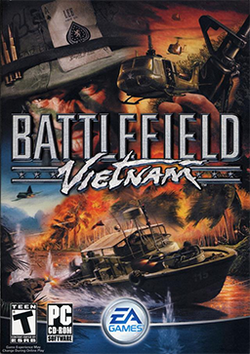Battlefield Vietnam
| Battlefield Vietnam | |
|---|---|
 |
|
| Developer(s) | Digital Illusions CE |
| Publisher(s) | Electronic Arts |
| Designer(s) | Armando Marini |
| Series | Battlefield |
| Engine | Refractor Engine |
| Platform(s) | Microsoft Windows |
| Release date(s) | |
| Genre(s) | First-person shooter |
| Mode(s) | Single-player, multiplayer |
| Aggregate scores | |
|---|---|
| Aggregator | Score |
| GameRankings | 84% |
| Metacritic | 84% |
| Review scores | |
| Publication | Score |
| GamePro | |
| GameSpot | 8.5/10 |
| IGN | 8.2/10 |
| X-Play | |
Battlefield Vietnam is a first-person shooter video game, the second in the Battlefield franchise after Battlefield 1942. The game was developed by the Swedish company Digital Illusions CE and published by Electronic Arts. Battlefield Vietnam takes place during the Vietnam War. It features a large variety of maps based on historical settings, such as the Ho Chi Minh Trail, Battle of Hue, Ia Drang Valley, Operation Flaming Dart, The Battle of Khe Sanh and Fall of Saigon. On 15 March 2005, EA re-released the game as Battlefield Vietnam: Redux, which includes new vehicles, maps, and an EA-produced World War II mod, based on the previous Battlefield 1942. On 31 May 2014, the game's multiplayer master servers went offline due to the GameSpy shutdown.
Battlefield Vietnam has the same point by point objectives of Battlefield 1942; in most maps, the objective is to take Control Points around the map to enable friendly players and controllable vehicles to spawn. Like other Battlefield games, Spawn tickets play a vital role for defeat of a Team. Battlefield Vietnam features a revolutionary form of asymmetrical warfare gameplay. The two teams (American or Vietnamese) are given wildly different kits and vehicles, making the U.S. rely more on heavy vehicles and the Vietnamese rely more on infantry tactics. The U.S., for instance, will get heavy tanks, helicopters, and bombers, while the Vietnamese are forced to rely on anti-tank/anti-aircraft weapons in order to stop the American side. This gameplay was intended to reflect the actual conditions of the war. The inclusion of a "Sipi Hole" for the Vietnamese – effectively a mobile spawn point, representative of the vast tunnel networks the Vietnamese used in the actual war – did a great deal to balance the gameplay.
...
Wikipedia
